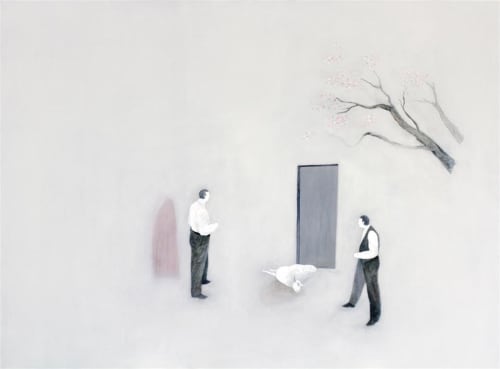Faceless, emotionless and sometimes limbless, Ibell's cast placidly watch carcasses, dead dogs and dead people, burning trees and burning buildings. They wait, emotionless and in vain, stuck in limbo for something to happen or someone to arrive.
Searching for answers in a nonsensical world, Alan Ibell's elusive narratives simulate the logic at work in dreams. His paintings examine the time-old discourse between spirituality, religion and superstition, while challenging the viewer’s preconceived perceptions of reality.
It could be said that Ibell’s paintings evoke the strange and sinister air of the New Zealand gothic genre and nod to artists such as Tony de Lautour, Tony Fomison and Jason Greig. Additionally there is an awareness of Surrealist artists and the Surrealist film genre (René Margritte’s The Man In The Bowler Hat, 1965, comes to mind), as well as an interest in the style and narrative of early Renaissance art. Literature has also played a role with writers such as Franz Kafka, Edgar Allen Poe, Albert Camus and those associated with the Theatre of the Absurd influencing the artist.
Ibell constantly draws, keeping a sketchbook of idea imagery to refer to. Working in series, he begins by exploring a narrative which he develops over a group of paintings. To achieve a grey fog-like surface and depth, he begins by blocking in details in thick layers of acrylic and slowly working over these with thin washes. Sometimes figures are painted out, leaving only a trace-like apparition. This layering effect allows Ibell to push or pull details, achieving the vaporous atmosphere he seeks.
In this fantastical dream world, things are out of whack (and a little bit disturbing). The spacious background and simple uniformity of the suited protagonists enable the artist to create a sense of timelessness as well as anonymity – they become unindividuated characters. Faceless, emotionless and sometimes limbless, Ibell's cast placidly watch carcasses, dead dogs and dead people, burning trees and burning buildings. They wait, emotionless and in vain, stuck in limbo for something to happen or someone to arrive.
A key feature of Ibell's work is this recurring dark, absurd and a tad humorous narrative. His interest in film noir and theatre is evident in his static compositions which are akin to cinematic stills or stage sets. Like dreams, there are parts missing from the expected narrative and composition. The absence of facial expression forces us to pay closer attention to body language, props and storyline. The Departure (Death of a Wild Dog) for instance, plays out like a bizarre crime scene. Two faceless businessmen stand close to a dead dog. They seem to be walking toward it, shoulders tilted, ankle deep in a misty fog which also envelops the sparse forest in the distance. These vulnerable husks of men remain emotionally ambiguous; going about their actions in a mundane 'just another day at the office' mode incongruous with the scene.
Ibell’s paintings offer a paradoxical game with no resolution. When the mind tries to recall details of memories and dreams, it’s often a faded, partial, distorted or even an illogical vision. This is the realm Ibell adeptly examines. Building on uncertainty and unease, his works construct a psychological dialogue, where the viewer is forced to connect with faceless figures inhabiting the silent, still, grey and ghostly no-mans-land of the mind.
Essay by Lydia Baxendell
BIOGRAPHY
Born: Christchurch
Lives: Melbourne, Australia
Education: Bachelor of Fine Arts, Otago Polytechnic School of Art
Awards/Distinctions: City of Dunedin Art Awards - First Prize (2010); Edinburgh Realty Premier Art Awards – First Prize (2009); Derivan Art Award, Otago Polytechnic School of Art (2007)
Collections: The James Wallace Arts Trust, Auckland
Articles: ‘Ibell acrylic takes top prize’, Otago Daily Times, Nov 2010; ‘A Year to Remember’ by Nigel Benson, Otago Daily Times, Dec 2009; ‘Postcards: Dunedin’ by Natalie Poland, Art News New Zealand, Spring 2009, pg 37; ‘Ibell wins major award’,Otago Daily Times, August 2009; ‘Young Artists Ex-cite’ by Catherine Wellington, The Star, Nov 2007
